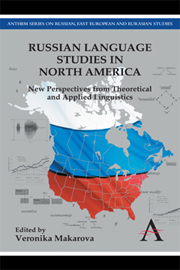Book contents
- Frontmatter
- Contents
- List of Tables and Figures
- Introduction
- Part One Language Structures and their Interface
- 1 Phonetics. Tracing Emotions in Russian Vowels
- 2 Phonology. Vowel–Zero Alternations in Russian Prepositions: Prosodic Constituency and Productivity
- 3 Morphology and Lexicology Interface. Latest Russian Neologisms: The Next Step towards Analytism?
- 4 Syntax. Bi-nominative Sentences in Russian
- 5 Psycholinguistics. The Effect of Grammatical Gender in Russian Spoken-Word Recognition
- Part Two Applied Linguistic and Sociolinguistic Analysis
- Afterword
- Index
1 - Phonetics. Tracing Emotions in Russian Vowels
from Part One - Language Structures and their Interface
Published online by Cambridge University Press: 05 November 2012
- Frontmatter
- Contents
- List of Tables and Figures
- Introduction
- Part One Language Structures and their Interface
- 1 Phonetics. Tracing Emotions in Russian Vowels
- 2 Phonology. Vowel–Zero Alternations in Russian Prepositions: Prosodic Constituency and Productivity
- 3 Morphology and Lexicology Interface. Latest Russian Neologisms: The Next Step towards Analytism?
- 4 Syntax. Bi-nominative Sentences in Russian
- 5 Psycholinguistics. The Effect of Grammatical Gender in Russian Spoken-Word Recognition
- Part Two Applied Linguistic and Sociolinguistic Analysis
- Afterword
- Index
Summary
The advantage of the emotions is that they lead us astray, and the advantage of science is that it is not emotional.
—Oscar Wilde (1891)Introduction
This chapter examines acoustic clues of six emotional states (neutral, surprise, happiness, anger, sadness and fear) in the production of Russian vowels. The findings are presented and discussed for three groups of vowels: unstressed, stressed and pitch accented. The research data come from the RUSLANA (Russian Language Affective) database of Standard Russian.
Emotions “convey the psychological state of a person” (Iliev et al. 2010, 445). They are “conceived to be natural bodily experiences and expressions, older than language, irrational and subjective, unconscious rather than deliberate, genuine rather than artificial, feelings rather than thoughts” (Edwards 1999, 272). Humans can express and identify emotions with a variety of communication forms including vocal (linguistic, verbal art) and non-vocal (facial expressions, shaking, changes in skin coloration, blood pressure, heart rate, sweating, posture, clothing, hairstyle, non-verbal art, gesticulation and behavioral patterns) (Anolli and Ciceri 2001; Iliev et al. 2010).
Expression of emotions in speech currently attracts scholars from a wide range of disciplines, such as literary criticism, neuroscience, anthropology, pragmatics, communication sciences, psychology, physiology, linguistics, applied linguistics, education, engineering, computer science, psychotherapy and psychiatry (Wierzbicka 1997; Johnstone and Scherer 2000; Pavlenko 2005; Imai 2007). All the structural levels and most functional forms of language serve to express emotions.
- Type
- Chapter
- Information
- Russian Language Studies in North AmericaNew Perspectives from Theoretical and Applied Linguistics, pp. 3 - 42Publisher: Anthem PressPrint publication year: 2012

